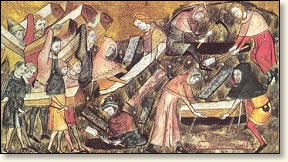Plague is found in some semi-arid areas in Asia, Eastern Europe, Africa, South America, and North America. In the United States, most cases in humans occur in two regions: 1) northern New Mexico, northern Arizona, and southern Colorado, and 2) California, southern Oregon, and far western Nevada.
In the southwestern United States, rock squirrel fleas are the most common source of infection in people. In the Pacific states, California ground squirrel fleas are the most common source. Many other types of rodents -- including other ground squirrels, prairie dogs, chipmunks, wood rats, wild mice, and voles -- suffer plague outbreaks and are occasional sources of human infection. Domesticates can be infected by fleas or by eating infected wild rodents and can be a direct source of infection to people. Dogs rarely suffer severe illness and have yet to be shown to be sources of infection for humans.
Ref: http://www.dhpe.org/infect/plague.html

